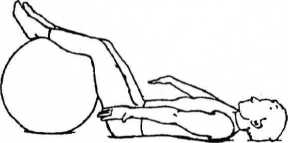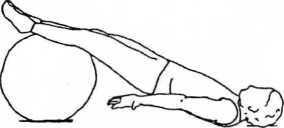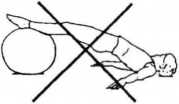img062

Datę. Name.
Hip Lift with Raised Arms-Spinal Stability 3.10
Starting Position: Lie on back. Put calves on bali and lift arms off floor at sides or reaching for ceiling.
Movement/Exercise: Find pain free position of the spine. Lift trunk as a single unit until body is in a linę from ankles to shoulders. Reverse and lower spine as a single unit.


C/łUT/OM. STAY WITHIN PAIN FREE RANGĘ. DO NOT ARCH BACK.

Breathing: Inhale when lifting, exhale when lowering. Modification:
1. Place bali closer to buttocks.
2. Lift only as far as comfort and balance allow.
Progression:
1. Place bali farther down legs to heels.
2. Pick one leg up off bali. Balance, lower leg on to bali. Alternate sides.
3. Pick up one leg and write alphabet in the air as big and fast as possible.
4. Add cuff weights at ankles.

Hołd_Seconds
Weights_
Repeat_Times
Do_Times/day
Purpose/ Goal;.
Comments: Lifting arms decreases the base of support challenging balance reactions and changing the center of gravity. Lifting one leg further challenges balance reactions whi!e training trunk stability and allowing for mobility of the arms and legs.
© 1995 by Joannę Posner-Mayer, PT
Advanced Hip Lift-Spinal Stability 3.11
Starting Position: Lie on back, and place calves on bali. Find pain free position of spine. Press arms into floor and lift trunk as a single unit until body is in a linę from ankles to shoulders. Keeping trunk still, lift one leg slightly off bali.

Movement/Exercise: Move leg out to side, allow knee to bend and cross ankle under supporting leg. Straighlen knee, returning leg out to side and adduct leg across and above supporting leg. Repeat. Return leg to bali and lower hips to floor.

CAUTIOH: STAY WITHIN PAIN FREE RANGĘ. KEEP HIPS PARALLEL TO FLOOR. DO NOT ARCH BACK.
Breathing: Breathe comfortably. Do not hołd breath.
Modification:
1. Lift trunk as far as comfort and balance allow.
2. Reduce rangę of motion of the leg.
Progression:
1. Place bali farther down legs to heels.
2. To decrease base of support, bend or lift arms off floor.
3. Add cuff weights to ankles.
Hołd__Seconds / Weights_ I Repeat_Times / Do_Times/day
Purpose/ Goal:.
Comments: Moving the teg keeps the center of gravity changing which challenges balance reactions and trunk stability and allows for mobility of the leg. Hip muscle strength can be assessed if hips drop and rise during exercise.
© 1995 by Joannę Posner-Mayer, PT 93
Wyszukiwarka
Podobne podstrony:
img056 Hip Lift with Bent Elbows-Spinal Mobility .3:6 Hip Lift with Raised Arms-Spinal Mobility 3:7
img060 Datę. Name.Hip Lift with Bent Elbows-Spinal Mobility 3:6 Starting Position:
img080 ;UWa ;UWa Datę. Name.Leg Rotation with Bali 6:10 Starting Position: Lie on
img061 Datę_ Name.Hip Lift-Spinal Stability 3:8 Starting Position: Lie on back. Pu
img051 Datę Name.Supine Trunk Rotation 2:6 Starting Position: Lie on back with kne
63618 img77b I Datę Name. Starting Position: Lie on back with calves on bali. IMovement/Exercise: St
img77b I Datę Name. Starting Position: Lie on back with calves on bali. IMovement/Exercise: Straight
więcej podobnych podstron